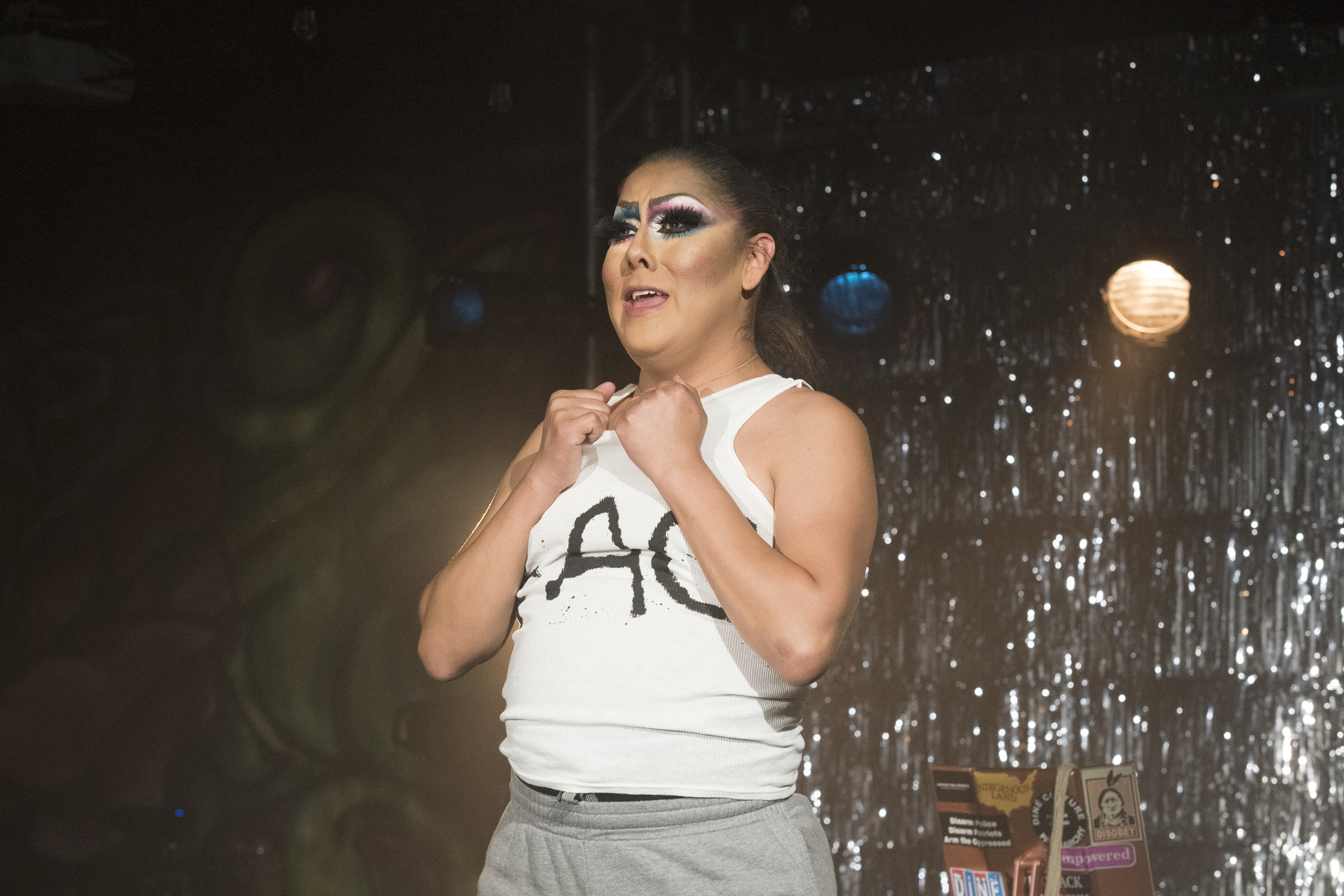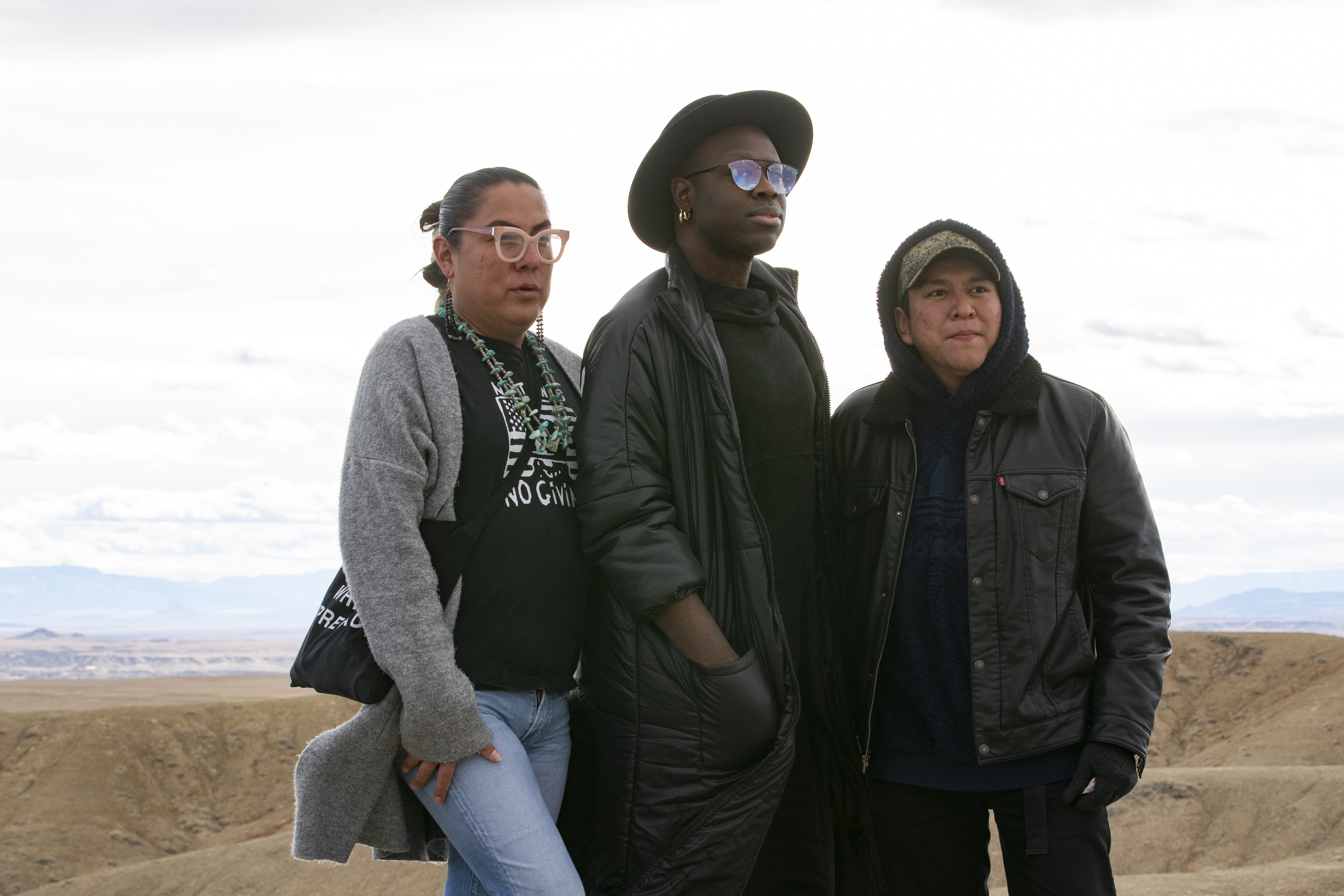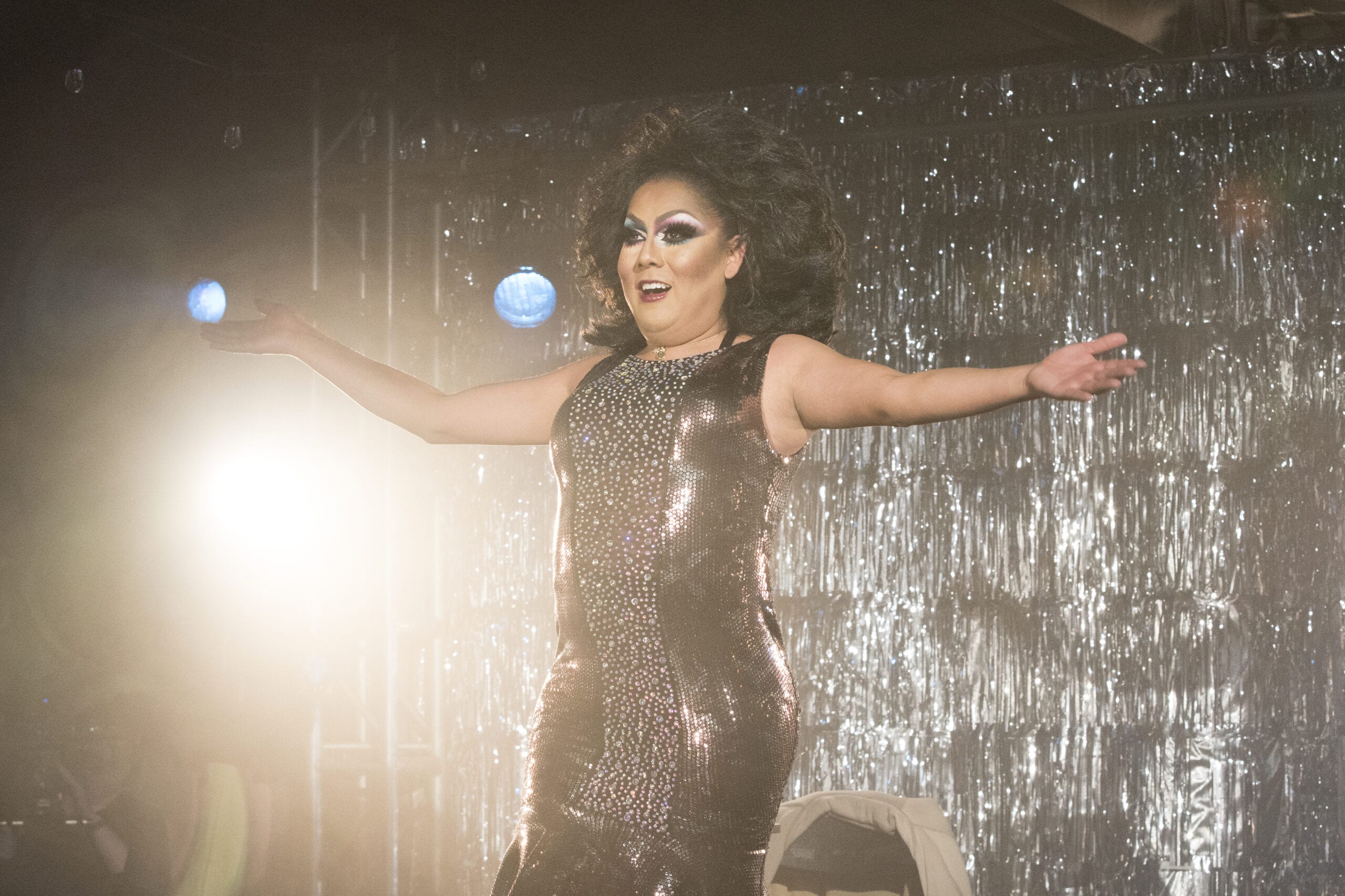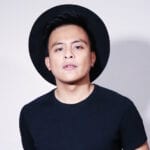Lady Shug waves as she pops onto the screen. She’s wearing a magenta dress, hoop earrings and the biggest smile. It’s 11 a.m. in New Mexico, where Lady Shug resides; yet, this early, she’s already in full drag and ready to share her story and her advocacy.
Lady Shug, a Diné non-binary drag artist from the Navajo Nation in New Mexico, has been a drag artist for years. She’s known to centre her culture and Indigeneity in her craft. Recently, she gained more mainstream recognition when she appeared on HBO’s Emmy-award nominated series We’re Here, and via her Instagram account where she posts fabulous photos alongside calls to action.
I hopped on a video call with Lady Shug to chat about her drag origins, her fabulous looks and intermingling drag with her culture.
When did you start doing drag?
Oh jeez, you’re gonna age me. I will say I’ve been doing drag for about 10-plus years. I started in the wonderful city of Las Vegas, Nevada—the entertainment capital of the world. And then I relocated back to my reservation to bring drag culture to my people.
Where did the name Lady Shug come from?
Actually, before Shug, my nickname was Sugar Booger. I used to hang around a bunch of the club kids in Los Angeles, and they used to call me Sugar Booger because they always said, “Oh gosh, Shug, you know you’re really sweet but your makeup and your drag is kind of boogerish.” Then when I moved to Vegas and I found my drag mother, Coco Vega, she was like, “No honey, you’re no booger. From now on, you are going to be named Lady Shug.” It just kind of stuck. (Mind you, I was the “Lady” before Lady Gaga—that’s probably how long I’ve been doing drag.)
How would you define your drag?
I would define my drag to be very political. In the beginning, I was predominantly just a pretty girl, glamour girl—I just wanted to be glamorous and that was about it. Now that I live back on my reservation and I see the struggles that my people go through, I feel like Shug’s drag has become more political and more in your face, questioning the boundaries and starting discussions.

Credit: Courtesy HBO
That’s powerful. I just want to expand that: How does being Indigenous inform your craft?
First and foremost, I’m very proud to be Indigenous. I try to intertwine my traditions into my drag: I try to bring Mother Nature, I try to bring different things that we signify as Diné people into my drag. But then, just being Indigenous and taking up and holding these spaces as an Indigenous queen is something that I’m truly thankful that I’m allowed to do in my art form. Even if they don’t want it, I still make my presence known.
You are very talented, and we’ve seen your amazing looks on Instagram. What inspires you?
I would say my inspiration comes from just growing up with really strong matriarchal role models: my mom, my aunts, my grandmas, my great-grandmas. I kind of get my power from them, and also from Mother Earth. I’m very keen to respect Mother Earth—she’s the reason why I’m here in front of you. And so I would just say, strong examples of matriarchy from my mom and my family, in general. But then, even from some of my friends and some of my fans that I know; their stories and their struggles of being a feminine relative empowers me, even if I don’t know them. I think the strength of femininity and girl power kind of fills up Lady Shug.
How do you manage to serve looks and look flawless posing in the middle of a desert?
That is the beautiful scenery of my nation, and I’m very fortunate to be living in such beautiful places like Arizona and New Mexico because I have houses in both areas. A little backstory on the finale of We’re Here when we did the lip sync: We did the video recording at the Shiprock Monument, which is really well-known in Hollywood, but a lot of people didn’t realize that it’s a sacred spot and is always protected by creatures and different things. Because it was springtime, there were a bunch of snakes. So we did a lot of takes where we were like, “Snake!” and we ran away. But in terms of looks, I think it’s just good old Spanx, maybe a little fan and a prayer to make sure you don’t sweat or nothing bites you.
It’s also the photographers. I’m very fortunate to work with Indigenous photographers such as Nate Lemuel, who was also featured on We’re Here. Working with really cool and artistic photographers makes it really easy for me and it just feels so natural.
In addition to posing in fabulous looks, you also post photos with captions proudly stating that you are an Indigenous, queer, non-binary drag artist. Why is saying that important to you?
I want to hold that space because, as an Indigenous non-binary queen, there are not many places that give us that platform or give us that space. It feels like we’re never included in the party. So I feel like it’s my duty to make sure people know that I am proud to be Indigenous, I’m proud to be non-binary, I’m proud to be a drag artist. I want to push those gates open for future generations and for other Indigenous queer and trans artists to feel comfortable putting themselves in these spaces.
“Even if they don’t want it, I still make my presence known.”
We’ve also seen you on We’re Here and how you supported Nate. Why is friendship so important to you?
It’s something that we have in our culture, from our tribe—it’s called kinship. Kinship is something that’s very strong, it keeps us sane. It keeps us safe. It makes the world go round. I don’t really call my friends “friends.” They are mostly like family. I was raised to be that way, and Nate is a beautiful soul. Actually, in our tradition, we have a thing called a clan system, and during filming we found out that we are related. I was really excited. Of course two talented family members would slay the screen!
Kinship is also something very important in my activism work. I try to help our unsheltered relatives here on the reservation as much as I can year-round because sometimes organizations and the government forget about them. That’s kinship: Providing mutual aid and giving somebody help, love and support. You don’t have to be Indigenous to give kinship, especially during this pandemic. We need to check up on each other. We need to make sure we’re okay—physically and mentally.
On the show, during Nate’s performance, you’re holding a sign saying “No More Missing Womxn.” How can we continue having these conversations about Missing and Murdered Indigenous Women Girls and Two-Spirit/LGBTQ+ people?
I believe wholeheartedly that it begins with education and with teaching your children what consent is, what respect is. I feel that we need to educate our fellows, our guys, about how to respect women and feminine relatives. I feel like this world is still a boys’ club, and the girls and the feminine relatives are on the bottom—we need to change that. We need to give space to our matriarchs, to our feminine relatives. We need to hold people accountable for their actions.
How does your drag inform your Indigenous community?
I think it turns a lot of heads, especially when I want to make a point, support a movement or make something political. In general, my personality’s kind of in-your-face: I’m going to make sure that you’re aware of my presence.
People on my reservation view Two-Spirit, queer and trans Indigenous Diné people to be wrong, because of the Bible or because of modern society. I’m trying to change that script, and let them know that there are people, like myself, who are at the forefront and who are sacred. We are not forgotten. I want to change that back to normalize it. And it’s really hard because religion has a lot to do with it here on my territory—there are actually more churches here on the Navajo Nation than there are grocery stores, which is kind of crazy.
As a performer, what is your favourite song to lip sync to?
Oh my god, you’re putting me on the spot for this one! That’s hard! I will do anything. Erykah Badu—that is my queen, anything from Erykah Badu. It hits my soul. I’m a Jill Scott fan, so throw me on some Jill Scott. Some Mary J. [Blige]—who doesn’t like Mary J.? You know, just powerful! I like to do a lot of songs by our female relatives, especially people of colour. I feel like we have similar stories, and just performing their music or their art amplifies them and gives them space to expand the reach of their music or their genre to people that might not normally listen to them.

Credit: Courtesy HBO
Who is your favourite drag artist?
I would have to say my drag family. My drag mother, Coco Vega. She’s a well-known pageant gown extraordinaire. And then also my drag sister, her name is Chichi Dela Cruz. Those are two people who mentored me.
But filming We’re Here, I fell in love with Bob The Drag Queen. There’s something about him, in his stance holding people of colour, and people of colour that do drag, so highly. He’s taught me—and, actually, he’s motivated me—to pursue more events and more of my craft. I’m very thankful that I met him, I’m very thankful that I experienced him and I’m very thankful that the world gets to meet him through We’re Here.
One thing that most people don’t know about you?
I’m a big coffee snob. I love coffee. But I like to help. And, of course, there it is again, you know, there goes Shug trying to help everybody! I like to help [and support] the local roasters.
I’m also a big foodie! Actually, I went to school for culinary. I love to cook, I love to entertain and I love to go try different restaurants and travel all over just to eat. Who doesn’t like coffee and food? Also, when I eat my candy, I have to divide the colours. As a child, I used to divide my colours and I would not eat a mixture of M&Ms, they had to be separated. So I don’t know if that tells you anything. I’m a Taurus. I’m very stubborn, very hard-headed, but I have the biggest heart.
What’s next for Lady Shug?
Oh my gosh, continuing to be a proud Indigenous drag queen and make my presence known, not just nationally but worldwide. Also, continuing to inspire my Indigenous folks and supporting people of colour—and taking over the world!
I hate to say “I’m going to do this or that.” I leave it to the world and what I put into it and what it’s going to give back. I’m excited to see what happens. Things happen for a reason. Let’s just see how long this Lady Shug roller coaster will last.
What is your advice to your teenage self?
Snap out of it! I don’t know because it’s hard! I’ll tell you two answers: One, I wouldn’t change anything because without all my struggles, all my heartache and all my downfalls that I went through as a teenager and as a young adult, I really feel like I wouldn’t be the person I am today. So I don’t know if I would want to change or tell my person anything. I think the one thing I would tell my young self is to continue to be proud of who you are, continue to be vocal because growing up we were always spoken for. We were always told not to speak out. I would say speak up more, be proud of who you are and it does get better.


 Why you can trust Xtra
Why you can trust Xtra


